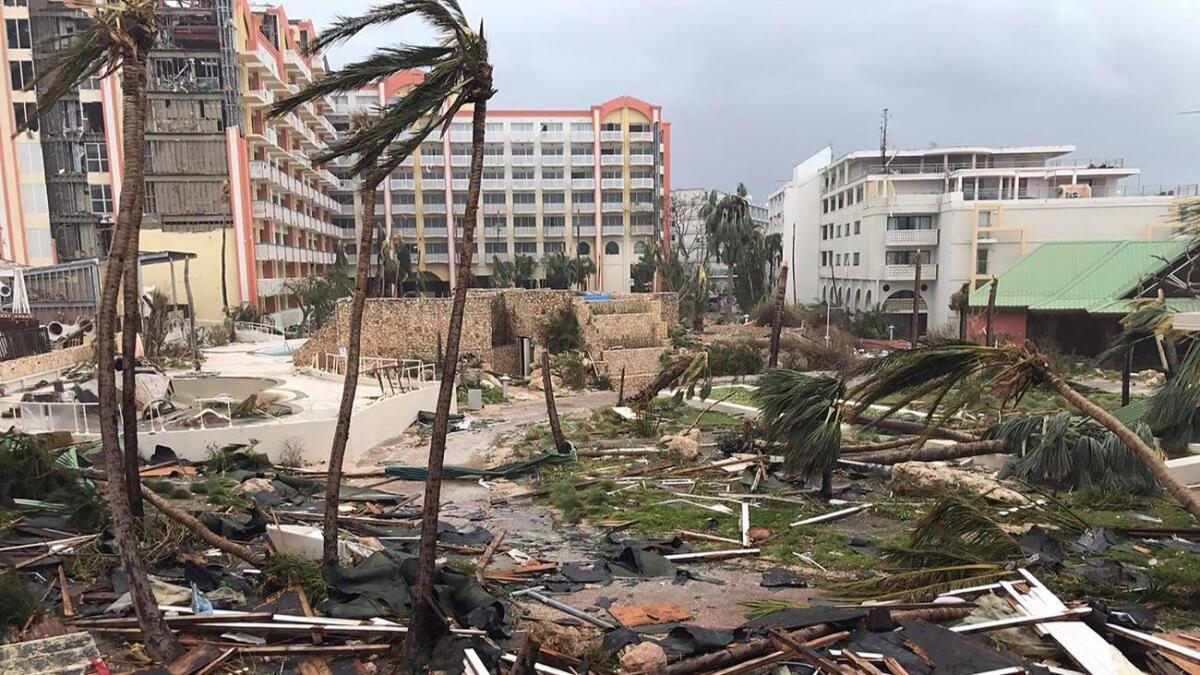Op-Ed: Greta Van Susteren: No two natural disasters are alike

- Share via
From Hurricanes Katrina to Maria, with Sandy, Harvey, Irma, and a Haitian earthquake in between, I’ve seen catastrophes up close, on the ground, either covering the news or assisting on relief missions. Sometimes both. In 12 years, I’ve learned one crucial fact about 21st century natural disasters: As Leo Tolstoy famously said about unhappy families, no two are alike. Each disaster is disastrous in its own way.
When Katrina made landfall in Mississippi and Louisiana in 2005, it was not simply the rain that caused devastation: It was the storm surge and failed levees. Katrina taught us a number of lessons, including the need to evacuate. But this year, those lessons didn’t protect Houston — where a full-scale evacuation was logistically and politically impractical. (A prior evacuation for another storm led to loss of life.) And they couldn’t prevent the complete destruction on the Caribbean islands in Irma’s path. The lessons of Katrina, Harvey, and Irma combined, moreover, cannot fix the increasingly desperate situation in Puerto Rico, where Maria ripped the bark off the trees, snapped bridges in half and turned a green island muddy brown.
In the last two weeks, I have been on the ground in Barbuda in the Caribbean, Florida and Puerto Rico. Despite the fact that each place was hit by a hurricane, the needs and the obstacles to recovery are different in each location. On Caribbean islands, damaged airport runways make it difficult if not impossible to land huge cargo planes filled with food, medicine and other supplies. As for ships, there’s limited harbor space (and of course, ships can be slow getting to the crisis).
We can’t preplan for every disaster scenario. If we did, we would end up hoarding resources that other people suffering in other places needed immediately.
In Puerto Rico, virtually the entire power grid was taken down. Electric lines that were fully functional two weeks ago were destroyed. No pre-Maria disaster scenario prepared the island for that level of chaos. The U.S. does not have spare power grids just lying around. Components will have to be acquired or manufactured. Beyond the power grid, bridges have been washed away and that means remote inland towns are inaccessible.
Volunteers coming to the island have no place to stay: hotels and shelters that might have accommodated them are gone or are being used by residents whose homes were destroyed. And every piece of aid has to arrive by boat or plane.
Yes, in Puerto Rico, where I visited on Monday, people are grateful to be alive and the adrenaline of survival has kept them going. But what happens when the food and gasoline and medicine remain at below subsistence levels in the coming weeks? How long can an entire population survive on gratitude? The answer is obvious: not long.
Disasters become disasters partly due to their magnitude, but also partly due to the element of surprise. Mother Nature does not issue a schedule a year in advance; she inflicts her wrath on a whim. It could be Miami. It could be Tampa. It could be Houston or San Juan. The supplies put together in Puerto Rico to help respond to Irma had to be “evacuated” when Maria approached.
We can’t preplan for every disaster scenario. If we did, we would end up hoarding resources that other people suffering in other places needed immediately.
But we can do two things: 1) Ensure from the start that there is centralized, coordinated leadership at the top. It helped to get a general with real authority to New Orleans after Katrina; it’s helping to do the same in Puerto Rico. Such a leader can get rid of red tape, so that supplies don’t arrive without people to unload them or, in the case of the Katrina evacuation, buses without drivers. 2) Recognize that you can’t make policy during a natural disaster. What you need is a five-day plan, then five-week, five-month, and even a five-year plan. Disasters last long after the media leaves.
When we read news stories about the horror and extreme suffering in disaster areas, most of us want a villain to blame, but that is not always fair. What I’ve seen over the last few weeks is people on the ground — men and women from our government and from private relief organizations — who are working really hard, very long hours, helping those in need. They are our greatest resource. They show up when there are TV cameras to cover them but also when there aren’t. They don’t worry about which elected officials visit, only if those officials can commandeer additional help. They deliver medicine and food and work to get potable water, or create private armadas to rescue flood victims. What we truly need, if we are to survive the next wave of disasters, each disastrous in their own way, are more people just like them.
Greta Van Susteren is a lawyer and former anchor of Fox News’ “On the Record.” Her book “Everything You Need to Know About Social Media” will be released Nov. 14. She traveled to Barbuda and Puerto Rico with the relief organization Samaritans Purse.
Follow the Opinion section on Twitter @latimesopinion or Facebook
More to Read
A cure for the common opinion
Get thought-provoking perspectives with our weekly newsletter.
You may occasionally receive promotional content from the Los Angeles Times.










